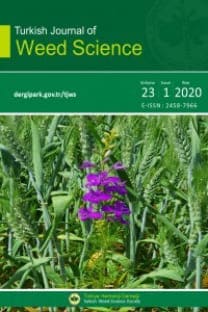Yıldız NEMLI, Ahmet KAYNAR, Akın KAYANDAN, Tülin ER, Süleyman TÜRKSEVEN, Ahmet Uğur DURU, Hakan ÖRNEK
Kalıntı Yönüyle Kimyon ve Anasonda Linuron, İsoproturon ve Bunların Metobolitlerinin Araştırılması
Bu çalışma, ihracata yönelik organik kimyonlarda isoproturon metaboliti (4-isopropil anilin) kalıntısının çıkması nedeniyle, sorunun aydınlatılması amacıyla yapılmıştır. Bu amaçla organik ve konvansiyonel anasonda ve kimyonda, linuron, isoproturon ve metabolitlerinin kalıntı durumu farklı gelişme dönemlerinde araştırılmıştır. Kalıntı analizleri için numuneler “Eurofins Dr. Specht Laboratorian - Almanya” na gönderilmiştir. Anasonda linuron ve isoproturon metaboliti kalıntısı uygulamadan 10 gün sonra en yüksek düzeyde (4.23 mg/kg) bulunmuş olup bu değer hasat döneminde ve kurutma sonrası düşüş (sırasıyla, 0.07 ve 0.01 mg/kg) göstermiştir. Benzer şekilde konvansiyonel kimyonda linuron ve isoproturon metaboliti ilk dönemde yüksek (4.4 – 2.51 mg/kg) bulunurken hasat öncesi ve kurutmada bu değer (0.28 – 0.20 mg/kg) düşüş göstermiştir. Organik anason ve kimyonda ise linuron metaboliti ve isoproturon kalıntısına rastlanmamıştır. Ancak kimyonun hasada yakın döneminde isoproturon metabolitinin limitin değerlerinin üzerinde bulunduğu (0.15 – 0.02 mg/kg) saptanmıştır. Isoproturon, gerek Türkiye de gerekse dünyada da kimyonda ruhsatlı değildir. Ayrıca genel olarak herbisit kalıntısının uygulama dönemini takiben yüksek daha sonra ise düşüş olması beklenir. Ancak isoproturon metaboliti 4 Isopropylanilin kimyonda uygulamadan 10 ve 24 gün sonra günlerde görülmemesine rağmen, hasat dönemine gelen bitkilerde ortaya çıkmaktadır. Bu durum kimyonun isoproturon metabolitine benzer doğal bir bileşik içerebileceği kanaatini uyandırmaktadır
Anahtar Kelimeler:
Linuron, Isoproturon, Anason, Kimyon
Determination of Isoproturon, Linuron and their Metabolites Residues in Cumin and Anise
This study was conducted to clarify the issue of Isoproturon metabolite residues in organic cumin creating problems during exports. For this purpose, presence the residues of linuron, isoproturon and their metabolites in conventionally and organically grown anise and cumin crops was tested at different growth stages. The samples collected at different stages of both plants were send to “Eurofin Dr. Specht Laboratorian Germany” for residues analysis. Highest amounts of residues of linuron and isoproturon metabloites in conventionally grown anise was observed 10 days after the application (4.23 mg/kg) and decrease was observed at harvesting and after drying (0.07 and 0.01 mg/kg, respectively). Similarly, in conventionally grown cumin; linuron and isoproturon metabloites residues were highest at initial growth stages (2.51-4.4 mg/kg) and decreased at harvest and after drying following harvest (0.28 and 0.20 mg/kg, respectively). Linuron metabolites and isoproturon residues were not detected in organically grown anise and cumin plants. However, a isoproturon metabloite (4-Isopropylanilin) was detected more than safe amount (0.15 – 0.02 mg/kg) in cumin near to harvest stage. Isoproturon is neither registered in Turkey nor in the World for use in cumin. Residues of herbicides are generally higher at the beginning of applications and decrease at the end of vegetation period. However, 4-Isopropylanilin were not detected at 10th and 24th days after application in cumin but were present near to the harvest. This study concludes that cumin might contain a natural product having resemblance to the isoproturon metabolite
Keywords:
Linuron, Isoproturon, Anise, Cumin,
___
- Anonymous. (2002). Herbicide Handbook. Weed Sci. Soc. Of America, USA X+493.
- Anonymous. (2015). Ruhsatlı Bitki Koruma Ürünleri. Tarım ve Köyişleri Bakanlığı Yayın Dairesi Başkanlığı. Ankara.
- Anonymous (2016). https://biruni.tuik.gov.tr/bitkiselapp/bitkisel.zul. [Erişim:Şubat 2016].
- Eurofins (2010). Eurofins Dr. Specht Laboratorian, Test Report: 10-46887
- Eurofins (2012). Eurofins Dr. Specht Laboratorian, Test Report: 12-72062/1
- Henze G., Mayer A., Hansen J. (1993). Determination of phenylurea herbicide linuron and its metobolites in enviromental samples by HPLC with serial ultraviolet and emperometric detection. Fresenius J. And Chem., 346 : 761-765.
- Khan SU., Belanger A., Hogue EJ., Hamilton HA., Matur SP. (1976). Residues of paraquat and linuron in an organic soil and their uptake by onions, lettuce and carrots. Can. J. Soil Sci., 56:407-412.
- Koesukwiwat U., Lehotay SJ., Mastovska K., Dorweiler KJ., Leepipatpiboon N. (2010). Extension of the QuEChERS
- Method for Pesticide Residues in Cereals to Flaxseeds, Peanuts, and Doughs. Journal of Agricultural and Food Chemistry, 58: 5950 – 5958.
- Lehotay SJ., Son KA., Kwon H., Koesukwiwat U., Fu W., Mastovska K., Hoh E., Leepipatpiboon N. (2010). Comparison of QuEChERS sample preparation methods for the analysis of pesticide residue in fruits and vegetables. Journal of Chromatohgraphy A, 1217: 2548 – 2560.
- Mastovska K., Dorweiler KJ., Lehotay SJ., Wegscheid JS., Szpylka KA. (2010). Pesticide Multiresidue Analysis in Cereal Grains Using Modified QuEChERS Method Combined with Automated Direct Sample Introduction GC – TOFMS and UPLC – MS / MS Techniques. Journal of Agricultural and Food Chemistry 58: 5959 – 5972.
- Morris RF., Penney BG. (1971). Persistance of Linuron residues in soils at kelligrews, newfoundland. Can. J. Plant Sci. 51:242-245.
- Mortimer AM. (1989). The biology of weeds in “R.J. Hence, K. Holly, Weed Control Handbook: Principles.” Blackwell Scientific Publications 552 pp.
- Navarro S., Bermejo S., Vela N., Hernandez J. (2009). Rate of loss simazine, terbuthylazine, isoproturon and methabenz, thiazuron during soil solorization, J. Of Agricultural and Food Chemistry 57 (14): 6375-6388.
- Özer Z., Kadıoğlu İ., Önen H., Tursun N. (2001). Herboloji (Yabancı Ot Bilimi) Gaziosmanpaşa Üniversitesi Ziraat 4 Fakültesi Yayınları No:20 Kitap Serisi No:10, 3. Baskı, Tokat.
- Perrin-Ganier C., Schiavon F., Morel J-L., Schiavon M. (2001). Effect of sludge-amendment or nutrient addition on the biodegradation of the herbicide iroproturon in soil. Chemosphere, 44:887-892.
- Sorensen SR., Aamand J. (2003). Rapid mineralisation of the herbicide isoproturon in soil from a peviously treated Danish Agricultural Field. Pest Menag. Sci., 59 (10) : 1118.
- Walker A., Jurado-Exposito M., Bending GD., Smith VJR. (2001). Spatial variability in the degradation rate of isoproturon in soil. Environmental Pollution, 111:407-415.
- ISSN: 1303-6491
- Başlangıç: 1998
- Yayıncı: Türkiye Herboloji Derneği
